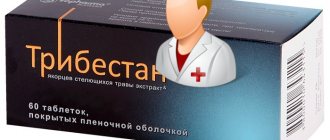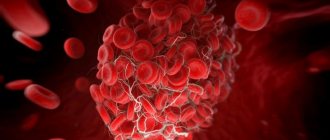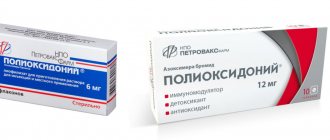pharmachologic effect
Antidepressant, propylamine derivative. The mechanism of action is associated with selective blockade of neuronal reuptake of serotonin into the central nervous system. Fluoxetine is a weak antagonist of cholinergic, adrenergic and histamine receptors. Unlike most antidepressants, fluoxetine does not appear to cause a decrease in the functional activity of postsynaptic β-adrenergic receptors. Helps improve mood, reduces feelings of fear and tension, eliminates dysphoria. Does not cause sedation. When taken in average therapeutic doses, it has virtually no effect on the functions of the cardiovascular and other systems.
Contraindications
Contraindications to the use of the drug
are: simultaneous use with MAO inhibitors (and within 14 days after their discontinuation); simultaneous use of thioridazine (and for 5 weeks after discontinuation of fluoxetine), pimozide; pregnancy; breastfeeding period; severe renal impairment (creatinine clearance less than 10 ml/min); liver failure; lactase deficiency, lactose intolerance, glucose-galactose malabsorption; age under 18 years; hypersensitivity to the drug.
Carefully
Suicidal risk: with depression, there is a possibility of suicide attempts, which may persist until stable remission occurs. Isolated cases of suicidal thoughts and suicidal behavior have been described during therapy or shortly after its completion, similar to the effects of other drugs with similar pharmacological action (antidepressants).
Epileptic seizures: Floxetine should be prescribed with caution to patients who have had epileptic seizures.
Hyponatremia: Cases of hyponatremia have been reported. Mostly, such cases were observed in elderly patients and in patients taking diuretics, due to a decrease in circulating blood volume.
Diabetes mellitus: glycemic control in diabetic patients during treatment with fluoxetine showed hypoglycemia; after discontinuation of the drug, hyperglycemia developed. Doses of insulin and/or oral hypoglycemic agents may need to be adjusted at the start or after treatment with fluoxetine.
Renal/liver failure: Fluoxetine is metabolized by the liver and excreted by the kidneys and gastrointestinal tract.
In patients with severe liver dysfunction, it is recommended to prescribe lower doses of fluoxetine, or prescribe the drug every other day. When taking fluoxetine at a dose of 20 mg/day for two months, there were no differences in the concentrations of fluoxetine and norfluoxetine in the blood plasma of healthy individuals with normal renal function and patients with severely impaired renal function (creatinine clearance 10 ml/min) requiring hemodialysis.
Among the main prohibitions on the use of the drug Fluoxetine are:
- breastfeeding period;
- various severe kidney dysfunctions;
- children under 18 years of age;
- liver failure;
- simultaneous use of pimozide, MAO inhibitors and thioridazine;
- convulsions of various origins;
- lactose intolerance;
- glaucoma;
- epilepsy;
- lactase deficiency and/or glucose-galactose malabsorption;
- hypersensitivity to the components of the product.
According to the instructions, Fluoxetine is contraindicated in the following cases:
- Individual intolerance to the drug;
- Atony of the bladder;
- Angle-closure glaucoma;
- Severe liver or kidney failure;
- Treatment with MAO inhibitors;
- Pregnancy and lactation;
- Increased tendency to commit suicide;
- Prostate hypertrophy.
The use of Fluoxetine in patients suffering from Parkinson's syndrome, epilepsy, diabetes mellitus or severe malnutrition requires special caution.
The drug is prescribed with caution to people suffering from anorexia. Although the drug is designed to improve the mental state, including in anorexics, a side effect of this drug can be progressive weight loss.
Diabetics taking this antidepressant should have their blood glucose levels checked regularly. The doctor must be prepared for the fact that, due to the prescription of an antidepressant, the dose of hypoglycemic drugs and insulin will have to be adjusted.
DETAILS: Children's Nazivin Sensitive: instructions for use for babies, price, reviews for children under one year old and during pregnancy
Pharmacokinetics
Absorbed from the gastrointestinal tract. Poorly metabolized during the “first pass” through the liver. Food intake does not affect the degree of absorption, although it may slow down its rate. Cmax in plasma is achieved after 6-8 hours. Css in plasma is achieved only after continuous administration for several weeks. Protein binding 94.5%. Easily penetrates the BBB. Metabolized in the liver by demethylation to form the main active metabolite, norfluoxetine.
T1/2 of fluoxetine is 2-3 days, norfluoxetine is 7-9 days. 80% is excreted by the kidneys and about 15% through the intestines.
Instructions for use of Fluoxetine
The dosage and frequency of taking the drug depend on the characteristics of the individual patient’s body, the indications that served as the reason for its prescription, and the result that needs to be achieved with its help. Manufacturers include standard instructions for use of the product with each package of Fluoxetine. It includes the following recommendations:
- The optimal dose at the beginning of treatment is 20 mg per day, in one dose;
- The maximum dose at any stage of the course of treatment is 80 mg in 2 or 3 doses;
- The duration of the course is from 1 to 4 weeks, depending on the symptoms and results.
If Fluoxetine is used for weight loss or treatment of bulimic neurosis, then the recommended dosage is 60 mg per day, divided into 2-3 doses at equal time intervals. Under no circumstances should an overdose of Fluoxetine be allowed.
If the patient cannot control his actions, then treatment is carried out in a hospital or under the constant supervision of relatives and a caregiver. Signs of an overdose may include excessive excitability of the patient for no apparent reason, changes in skin color, heart rate, nausea and vomiting. In this case, immediately call an ambulance and rinse the stomach as quickly as possible.
Be sure to read: Features of using PH-Modified creatine in a sports diet
Drug interactions
When used simultaneously with drugs that have a depressant effect on the central nervous system, ethanol may significantly enhance the depressant effect on the central nervous system, as well as increase the likelihood of developing seizures.
When used simultaneously with MAO inhibitors, furazolidone, procarbazine, tryptophan, the development of serotonin syndrome (confusion, hypomanic state, motor restlessness, agitation, convulsions, dysarthria, hypertensive crisis, chills, tremor, nausea, vomiting, diarrhea) is possible.
With simultaneous use, fluoxetine inhibits the metabolism of tricyclic and tetracyclic antidepressants, trazodone, carbamazepine, diazepam, metoprolol, terfenadine, phenytoin, which leads to an increase in their concentration in the blood serum, increasing their therapeutic and side effects.
With simultaneous use, it is possible to inhibit the biotransformation of drugs metabolized with the participation of the CYP2D6 isoenzyme.
When used simultaneously with hypoglycemic agents, their effect may be enhanced.
There are reports of increased effects of warfarin when used simultaneously with fluoxetine.
When used simultaneously with haloperidol, fluphenazine, maprotiline, metoclopramide, perphenazine, pericyazine, pimozide, risperidone, sulpiride, trifluoperazine, cases of the development of extrapyramidal symptoms and dystonia have been described; with dextromethorphan - a case of the development of hallucinations has been described; with digoxin - a case of increased concentration of digoxin in the blood plasma.
When used simultaneously with lithium salts, an increase or decrease in the concentration of lithium in the blood plasma is possible.
With simultaneous use, it is possible to increase the concentration of imipramine or desipramine in the blood plasma by 2-10 times (may persist for 3 weeks after discontinuation of fluoxetine).
When used simultaneously with propofol, a case was described in which spontaneous movements were observed; with phenylpropanolamine - a case is described in which dizziness, weight loss, and hyperactivity were observed.
With simultaneous use, it is possible to enhance the effects of flecainide, mexiletine, propafenone, thioridazine, zuclopenthixol.
Fluoxetine
pharmachologic effect
An antidepressant from the group of selective serotonin reuptake inhibitors.
It has a thymoanaleptic and stimulating effect. Selectively blocks the reverse neuronal uptake of serotonin (5HT) at the synapses of neurons in the central nervous system. Inhibition of serotonin reuptake leads to an increase in the concentration of this neurotransmitter in the synaptic cleft, enhancing and prolonging its effect on postsynaptic receptor sites. By increasing serotonergic transmission, fluoxetine inhibits neurotransmitter metabolism through the negative membrane binding mechanism. With long-term use, fluoxetine inhibits the activity of 5-HT1 receptors. Weakly affects the reuptake of norepinephrine and dopamine. It has no direct effect on serotonin, m-cholinergic, H1-histamine and alpha-adrenergic receptors. Unlike most antidepressants, it does not cause a decrease in the activity of postsynaptic beta-adrenergic receptors.
Effective for endogenous depression and obsessive-compulsive disorders. It has an anorexigenic effect and can cause weight loss. Does not cause orthostatic hypotension, sedation, and is noncardiotoxic. A lasting clinical effect occurs after 1-2 weeks of treatment.
Pharmacokinetics
When taken orally, the drug is well absorbed from the gastrointestinal tract (up to 95% of the dose taken); administration with food slightly inhibits the absorption of fluoxetine. Cmax in blood plasma is reached after 6-8 hours. The bioavailability of fluoxetine after oral administration is more than 60%. The drug accumulates well in tissues, easily penetrates the blood-brain barrier, binding to blood plasma proteins is more than 90%. Metabolized in the liver by demethylation to the active metabolite norfluoxetine and a number of unidentified metabolites. It is excreted by the kidneys in the form of metabolites (80%) and the intestines (15%), mainly in the form of glucuronides. T1/2 of fluoxetine after reaching equilibrium concentration in the blood plasma is about 4-6 days. T1/2 of the active metabolite of norfluoxetine with a single dose and after reaching equilibrium concentration in the blood plasma ranges from 4 to 16 days. In patients with liver failure, the half-life of fluoxetine and norfluoxetine is prolonged.
Indications
- depression of various origins;
— obsessive-compulsive disorders;
- bulimic neurosis.
Dosage regimen
The drug is taken orally, at any time, regardless of meals.
Depressive state
The initial dose is 20 mg 1 time / day in the first half of the day, regardless of meals. If necessary, the dose can be increased to 40-60 mg/day, divided into 2-3 doses (by 20 mg/day weekly). The maximum daily dose is 80 mg in 2-3 doses.
The clinical effect develops 1-2 weeks after the start of treatment; in some patients it may be achieved later.
Obsessive-compulsive disorders
The recommended dose is 20-60 mg/day.
Bulimic neurosis
The drug is used in a daily dose of 60 mg, divided into 2-3 doses.
Use of the drug in patients of different ages
There are no data on changes in doses depending on age. Begin treatment of elderly patients
follows with a dose of 20 mg/day.
Accompanying illnesses
Prescribe fluoxetine to patients with impaired liver or kidney function
It is recommended to use low doses and lengthen the interval between doses.
Side effect
When using fluoxetine, as in cases of using drugs from the group of selective serotonin reuptake inhibitors, the following adverse events are noted.
From the cardiovascular system:
often (≥ 1% - ≤10%) - atrial flutter, hot flashes; uncommon (≥ 0.1% - ≤1%) - hypotension; rarely (≤ 0.1%) - vasculitis, vasolidation.
From the digestive system:
very often (≥ 10%) - diarrhea, nausea; often (≥ 1% - ≤10%) - dry mouth, dyspepsia, vomiting; infrequently (≥ 0.1% - ≤1%) - dysphagia, taste perversion; rarely (≤ 0.1%) - pain along the esophagus.
From the hepatobiliary system:
rarely (≤ 0.1%) - idiosyncratic hepatitis.
From the immune system:
very rarely (≤ 0.1%) - anaphylactic reactions, serum sickness.
Metabolic and nutritional disorders:
often (≥ 1% - ≤10%) - anorexia (including weight loss) of the body.
From the musculoskeletal system:
infrequently (≥ 0.1% - ≤1%) - muscle twitching.
From the side of the central nervous system:
very often (≥ 10%) - headache; often (≥ 1% - ≤10%) - impaired attention, dizziness, lethargy, drowsiness (including hypersomnolence, sedation), tremor; infrequently (≥ 0.1% - ≤1%) - psychomotor agitation, hyperactivity, ataxia, incoordination, bruxism, dyskinesia, myoclonus; rarely (≤ 0.1%) - bucco-glossal syndrome, seizures, serotonin syndrome.
Mental disorders:
very often (≥ 10%) - insomnia (including early morning awakening, initial and moderate insomnia); often (≥ 1% - ≤ 10%) - unusual dreams (including nightmares), nervousness, tension, decreased libido (including lack of libido), euphoria, sleep disorder; infrequently (≥ 0.1% - ≤1%) - depersonalization, hyperthymia, impaired orgasm (including anorgasmia), thinking disorders; rarely (≤ 0.1%) - manic disorders.
From the skin:
often (≥ 1% - ≤10%) - hyperhidrosis, itching, polymorphic skin rash, urticaria; uncommon (≥ 0.1% - ≤1%) - ecchymosis, tendency to bruise, alopecia, cold sweat; rarely (≤ 0.1%) - angioedema, photosensitivity reactions.
From the senses:
often (≥ 1% - ≤10%) - blurred vision; infrequently (≥ 0.1% - ≤1%) - mydriasis.
From the genitourinary system:
often (≥ 1% - ≤10%) - frequent urination (including pollakiuria), ejaculation disorders (including lack of ejaculation, dysfunctional ejaculation, early ejaculation, delayed ejaculation, retrograde ejaculation), erectile dysfunction, gynecological bleeding (including including bleeding from the cervix, dysfunctional uterine bleeding, bleeding from the genital tract, menometrorrhagia, menorrhagia, metrorrhagia, polymenorrhea, postmenopausal bleeding, uterine bleeding, vaginal bleeding); uncommon (≥ 0.1% - ≤1%) - dysuria; rarely (≤ 0.1%) - sexual dysfunction, priapism.
Post-marketing messages
From the endocrine system
Cases of antidiuretic hormone deficiency have been reported.
These side effects more often occur at the beginning of fluoxetine therapy or when the dose of the drug is increased.
Contraindications
- simultaneous use with MAO inhibitors (and within 14 days after their discontinuation);
- simultaneous use of thioridazine (and for 5 weeks after discontinuation of fluoxetine), pimozide;
- pregnancy;
- period of breastfeeding;
- severe renal dysfunction (creatinine clearance less than 10 ml/min);
- liver failure;
- lactase deficiency, lactose intolerance, glucose-galactose malabsorption;
— age up to 18 years;
- hypersensitivity to the drug.
Carefully _
Suicidal risk
: with depression, there is a possibility of suicide attempts, which can persist until stable remission occurs. Isolated cases of suicidal thoughts and suicidal behavior have been described during therapy or shortly after its completion, similar to the effects of other drugs with similar pharmacological action (antidepressants). Careful monitoring of patients at risk is necessary. Clinicians should encourage patients to promptly report any distressing thoughts or feelings.
Epileptic seizures
: Floxetine should be prescribed with caution to patients who have had epileptic seizures.
Hyponatremia
: Cases of hyponatremia have been reported. Mostly, such cases were observed in elderly patients and in patients taking diuretics, due to a decrease in circulating blood volume.
Diabetes
: glycemic control in diabetic patients during treatment with fluoxetine showed hypoglycemia, after discontinuation of the drug hyperglycemia developed. Doses of insulin and/or oral hypoglycemic agents may need to be adjusted at the start or after treatment with fluoxetine.
Kidney/liver failure
: Fluoxetine is metabolized in the liver and excreted through the kidneys and gastrointestinal tract. In patients with severe liver dysfunction, it is recommended to prescribe lower doses of fluoxetine, or prescribe the drug every other day. When taking fluoxetine at a dose of 20 mg/day for two months, there were no differences in the concentrations of fluoxetine and norfluoxetine in the blood plasma of healthy individuals with normal renal function and patients with severely impaired renal function (creatinine clearance 10 ml/min) requiring hemodialysis.
Pregnancy and lactation
Contraindicated during pregnancy and lactation.
special instructions
Careful monitoring of patients with suicidal tendencies is required, especially at the beginning of treatment. The risk of suicide is highest in patients who have previously taken other antidepressants and in patients who experience excessive fatigue, hypersomnia, or restlessness during treatment with fluoxetine. Until significant improvement in treatment occurs, such patients should be under medical supervision.
In children, adolescents and young adults (under 24 years of age) with depression and other mental disorders, antidepressants, compared with placebo, increase the risk of suicidal thoughts and suicidal behavior. Therefore, when prescribing fluoxetine or any other antidepressants in children, adolescents and young adults (under 24 years of age), the risk of suicide should be weighed against the benefits of their use. In short-term studies, the risk of suicide did not increase in people over 24 years of age, but it decreased slightly in people over 65 years of age. Any depressive disorder itself increases the risk of suicide. Therefore, during treatment with antidepressants, all patients should be monitored for early detection of disturbances or changes in behavior, as well as suicidality.
During electroconvulsive therapy, prolonged epileptic seizures may develop.
The interval between the end of therapy with MAO inhibitors and the start of treatment with fluoxetine should be at least 14 days; between the end of treatment with fluoxetine and the start of therapy with MAO inhibitors - at least 5 weeks.
After discontinuation of the drug, its therapeutic concentration in the blood serum may remain for several weeks.
In patients with diabetes mellitus, hypoglycemia may develop during fluoxetine therapy and hyperglycemia after its discontinuation. Doses of insulin and/or oral hypoglycemic agents may need to be adjusted at the start or after treatment with fluoxetine.
When treating patients with underweight, anorexigenic effects should be taken into account (progressive weight loss is possible).
While taking fluoxetine, you should refrain from drinking alcohol, because. the drug enhances the effect of alcohol.
Impact on the ability to drive vehicles and operate machinery
Taking fluoxetine may negatively affect the performance of work requiring a high speed of mental and physical reactions (control of mechanical
Overdose
Symptoms:
psychomotor agitation, seizures, drowsiness, heart rhythm disturbances, tachycardia, nausea, vomiting.
Other serious symptoms of fluoxetine overdose (both when fluoxetine was taken alone and when taken concomitantly with other drugs) included coma, delirium, QT prolongation and ventricular tachyarrhythmia, including atrial fibrillation and cardiac arrest, decreased blood pressure, syncope, mania, pyrexia, stupor and neuroleptic malignant syndrome-like state
Treatment:
Specific antagonists to fluoxetine have not been found. Symptomatic therapy is carried out, gastric lavage with the administration of activated charcoal, for convulsions - diazepam, maintenance of breathing, cardiac activity, body temperature.
Drug interactions
Fluoxetine and its main metabolite, norfluoxetine, have long half-lives, which must be taken into account when combining fluoxetine with other drugs, as well as when replacing it with another antidepressant.
The drug should not be used simultaneously with MAO inhibitors, incl. antidepressants - MAO inhibitors; furazolidone, procarbazine,
selegiline, as well as tryptophan
(a precursor of serotonin), since the development of serotonergic syndrome is possible, manifested in confusion, hypomanic state, psychomotor agitation, convulsions, dysarthria, hypertensive crises, chills, tremor, nausea, vomiting, diarrhea.
After using MAO inhibitors, fluoxetine should be prescribed no earlier than 14 days. MAO inhibitors should not be used earlier than 5 weeks after stopping fluoxetine.
Simultaneous use of drugs metabolized with the participation of the CYP2D6 isoenzyme ( carbamazepine, diazepam, propafenone)
with fluoxetine should be carried out using minimal therapeutic doses.
Fluoxetine blocks the metabolism of the tricyclic and tetracyclic anti-depressive drugs trazodone, metoprolol, terfenadine,
which leads to an increase in their concentration in the blood serum, enhancing their effect and increasing the frequency of complications.
In patients stable on maintenance doses of phenytoin
, plasma phenytoin concentrations increased significantly and symptoms of phenytoin toxicity (nystagmus, diplopia, ataxia and central nervous system depression) appeared after initiation of concomitant treatment with fluoxetine.
Combined use of fluoxetine and lithium salts
, requires careful monitoring of the concentration of lithium in the blood, because it is possible to increase it.
Fluoxetine enhances the effect of hypoglycemic drugs
.
When used simultaneously with drugs that are highly protein bound, especially anticoagulants and digitoxin
, it is possible to increase the plasma concentration of free (unbound) drugs and increase the risk of adverse effects.
Conditions for dispensing from pharmacies
The drug is available with a prescription.
Storage conditions and periods
In a dry place, protected from light, at a temperature not exceeding 25°C. Keep out of the reach of children. Shelf life: 3 years.
FLUOXETINE: SIDE EFFECTS
From the side of the central nervous system: anxiety, tremor, nervousness, drowsiness, headache, sleep disturbances are possible.
From the digestive system: diarrhea, nausea are possible.
From the metabolic side: increased sweating, hypoglycemia, hyponatremia are possible (especially in elderly patients and with hypovolemia).
From the reproductive system: decreased libido.
Allergic reactions: possible skin rash, itching.
Other: joint and muscle pain, difficulty breathing, increased body temperature.
Side effects
If a person does not follow the recommendations of the attending physician regarding the dosage or frequency of taking the medication, he may experience the following undesirable consequences:
- persistent dizziness;
- cephalgia;
- dyspeptic disorders;
- diarrhea;
- blurred vision;
- excessive sweating;
- sleep disorders;
- libido change.
Sometimes allergic manifestations are observed, for example, urticaria, itchy skin. It is imperative to notify the attending physician about all of the above undesirable effects so that pharmacotherapy can be adjusted.
special instructions
Use with extreme caution in patients with impaired liver and kidney function, a history of epileptic seizures, and cardiovascular diseases.
In patients with diabetes mellitus, changes in blood glucose levels may occur, which requires adjustment of the dosage regimen of hypoglycemic drugs. When used in weakened patients while taking fluoxetine, the likelihood of developing epileptic seizures increases.
With the simultaneous use of fluoxetine and electroconvulsive therapy, the development of prolonged epileptic seizures is possible.
Fluoxetine can be used no earlier than 14 days after discontinuation of MAO inhibitors. The period after discontinuation of fluoxetine before starting therapy with MAO inhibitors should be at least 5 weeks.
Elderly patients require dosage adjustment.
The safety of fluoxetine in children has not been established.
During the treatment period, avoid drinking alcohol.
Impact on the ability to drive vehicles and operate machinery
During the treatment period, you should refrain from potentially hazardous activities that require increased attention and rapid psychomotor reactions.
Comparison of addiction between Zoloft and Fluoxetine
Like safety, addiction also involves many factors that must be considered when evaluating a drug.
So, the totality of the values of such parameters as “o syndrome” in Zoloft is quite similar to the similar values in Fluoxetine. Withdrawal syndrome is a pathological condition that occurs after the cessation of intake of addictive or dependent substances into the body.
And resistance is understood as initial immunity to a drug; in this it differs from addiction, when immunity to a drug develops over a certain period of time. The presence of resistance can only be stated if an attempt has been made to increase the dose of the drug to the maximum possible. At the same time, Zoloft has a fairly low incidence of “syndrome”, just like Fluoxetine.












